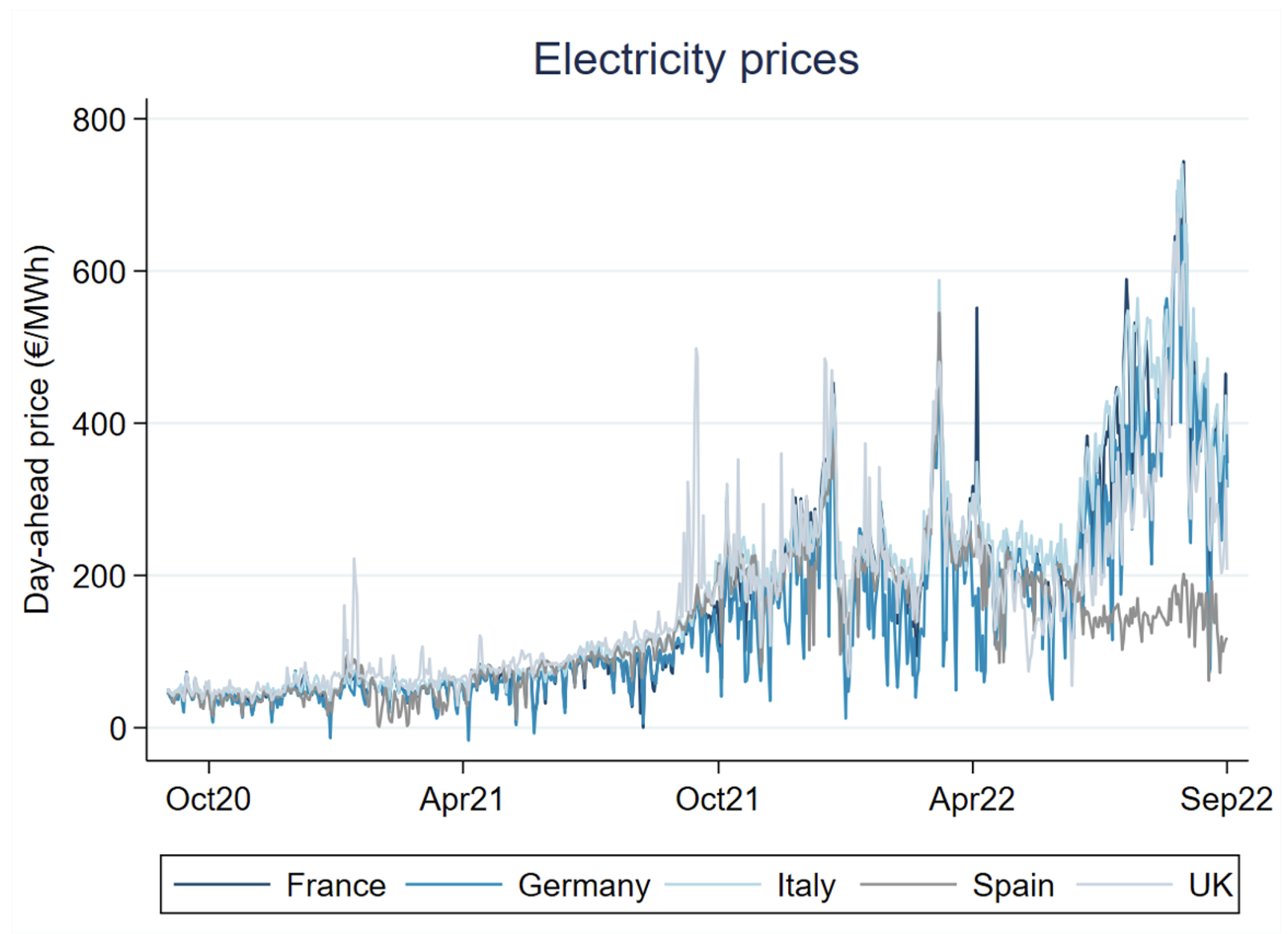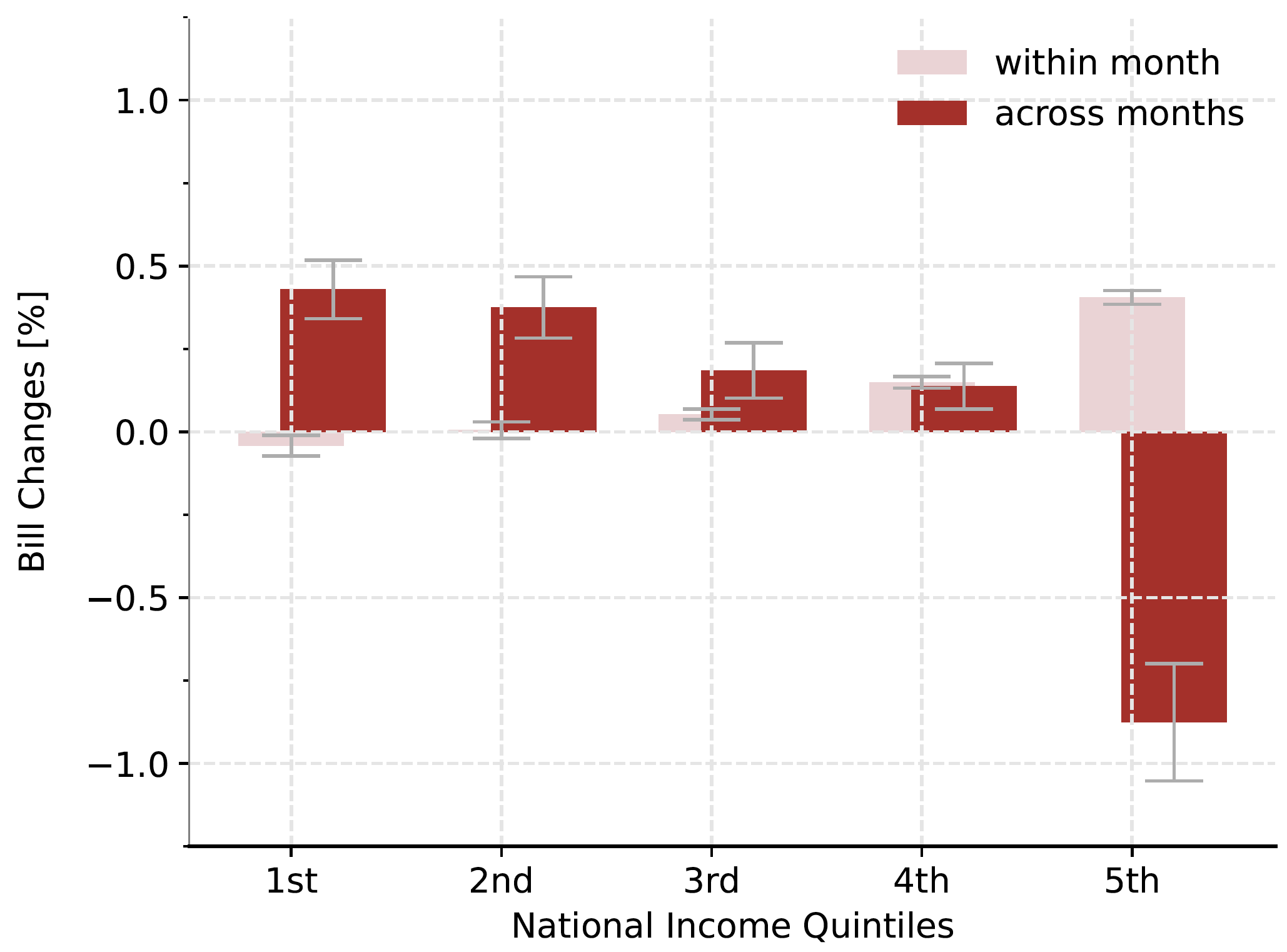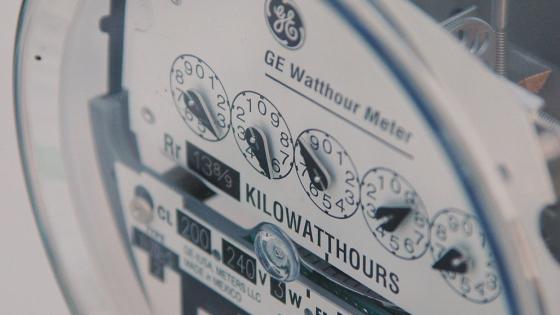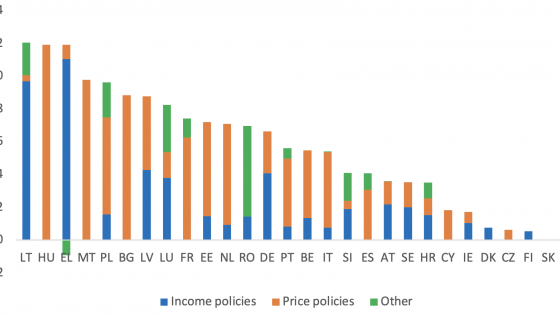Across Europe, electricity prices have reached record-high levels. In October 2020, Europe’s average wholesale electricity price was around €30 per megawatt hour (€/MWh). Two years later, it exceeded 300€/MWh, i.e. more than a ten-fold increase. The reasons are well known: the increase in the gas price triggered by the conflict with Russia has pushed up the marginal cost of producing electricity in gas plants, leading to inflated wholesale electricity prices. The damages have been felt across the economy, with EU inflation hitting a record 10% in September. This sizeable impact should not be surprising, given that electricity consumption is relatively inelastic and widely consumed in all sectors of the economy.
Figure 1 Wholesale electricity prices across Europe in September 2020-September 2022
The increase in electricity prices has had distributional consequences across consumers. The rise in electricity prices has made them all worse off, but some consumers have been relatively more affected than others. Those consumers tied to time-invariant prices have suffered from the increase in average prices. Instead, those exposed to the hourly wholesale electricity price changes have suffered a different price impact depending on whether they consume at peak times, when prices are higher, or at off-peak times, when prices are lower. A natural question arises: have the distributional consequences of the energy crisis been more or less pronounced among consumers under time-varying or under time-invariant prices?
The lack of detailed hourly consumption data at the consumer level over the last year makes it impossible for us to explore this issue in detail. However, our recent work provides a framework to analyse this question once the data becomes available.
In a paper with Michael Cahana and Jinyuang Wang (Cahana et al. 2022), we analyse the distributional consequences of switching households from time-invariant prices to prices that reflect the changing costs of meeting electricity demand –the so-called ‘real-time pricing policy’ (RTP). We do so in the context of the Spanish electricity market, the only country where RTP has been broadly rolled out since it became the default option for all households in 2015. Economists often favour RTP as an efficient pricing policy (Borenstein and Holland 2005), as it encourages conservation at high-price high-cost hours and demand shifting from high- to low-cost hours. In turn, this is expected to bring additional benefits, such as a mitigation of market power, a reduction in backup capacity needed to meet the peaks of demand, and improved use of renewable energies, which tend to drive electricity prices down. However, the widespread fear that RTP would give rise to adverse distributional implications has likely hindered its adoption in other jurisdictions (Joskow and Wolfram 2012).
Access to smart-meter hourly electricity consumption data of over 1 million Spanish households from 2016 to 2017 has allowed us to compute their bills under RTP and a time-invariant revenue-neutral price. Our analysis quantifies the bill change after the switch from time-invariant prices to RTP, investigates whether those bill changes correlate positively or negatively with households' income, and uncovers the underlying mechanisms that make the policy progressive or regressive. The underlying assumption is that consumption patterns would have remained unchanged under the two pricing policies. This assumption is justified by our previous work with David Rapson and Jingyuan Wang (Fabra et al. 2021) showing that the short-run elasticity of Spanish households to changes in real-time prices was not significantly different from zero, at least during this period.
To correctly estimate the distributional impacts of RTP, it is critical to uncover households' income heterogeneity. Yet, data on households' income are not available. Beyond their consumption patterns, we only know their zip codes. Lack of individual income data is a common challenge in many contexts where researchers have access to rich individual data (e.g. health outcomes, education, employment histories, etc.) but lack precise information about their income. Assigning the observed income distribution at the zip code level to each household would hide the within-zip-code distributional effects, potentially biasing the conclusions (Borenstein 2012).
To avoid this bias, we develop a novel method that combines individual electricity consumption data with the income distribution at the zip code level to assign a probabilistic income distribution to each household. The approach follows two steps. In the first step, we use flexible classification algorithms to assign households to a discrete number of representative types according to their consumption profiles. For example, the resulting clusters may group those households consuming mostly during weekdays at lunchtime and in the evening, those who consume primarily at night, or those consuming mostly during weekends. In the second step, we estimate the probability that each of such types has a certain income level. We do so by imposing that the distribution of income based on our household types matches the (observed) probability of income distribution at the zip code level using a generalised method of moments. This method gives us a probability of certain types having a particular income level.
A similar approach could prove valuable in other settings where income heterogeneity matters. For instance, suppose that we want to measure the distributional implications of carbon taxes, and as Chanut (2022), we have scanner data but lack individual income data. One could classify consumers into types according to their consumption bundles, and our proposed approach would then deliver their estimated incomes given those types. A similar approach could be used to analyse the relationship between income and health outcomes (using the patient’s medical records) or between income and retirement decisions (using tenure, experience, and health if available at the individual level through survey data), to name just two.
Relying on our estimated household-level incomes, we find that switching from time-invariant prices to RTP gave rise to regressive effects. This is shown in Figure 2, which classifies households into five national quintiles. One can see that the electricity bills of the low-income households increase after the switch, while those of the high-income households go down. Interestingly, this effect would have remained hidden if we had assigned households the average income within their zip codes. Under this approach, the policy's impacts would have seemed uncorrelated with income or just very modestly, with low-income households benefiting on average from the switch to RTP.
Figure 2 Bill changes due to the switch from time-invariant prices to RTP
Three mechanisms underlie this conclusion: hourly consumption patterns, electric appliance ownership, and locations. First, analysing households' consumption patterns during the day, we find that high-income households consume disproportionally more during peak hours when prices tend to be higher. Hence, switching from time-invariant prices during the day to RTP would favour low-income consumers (as shown by the pink bars in Figure 3). However, differences in consumption patterns across income groups during the year deliver the opposite conclusion. Since low-income households tend to consume disproportionally more during the winter, when prices tend to be higher, the switch to RTP would make them worse off (as shown by the red bars in Figure 3). Given that price differences across months are more pronounced than price differences within the day, the second effect dominates, making the policy change overall regressive.
Figure 3 Decomposing the bill impacts in the within-month and across-months effects
Differences in electric appliance ownership (electric heating and air conditioning) and locations account for those differences in consumption patterns. In Spain, low-income households tend to have disproportionally more electric heating and less air conditioning, which explains why they consume more in winter and less in summer. In turn, three facts drive the heating patterns: gas heating is not everywhere available (e.g. in rural areas, there is no gas infrastructure), it requires an expensive upfront investment, and some regions with mild winters tend to have lower income than the national average. As Christian Gollier nicely summarised our results on Twitter, "by imposing a uniform price per KWh across the year, the air conditioning of the rich cross-subsidizes the electric heating of the poor."
What does this evidence tell us about the likely distributional effects of RTP during the current energy crisis? Even though the lack of actual data prevents us from analysing this question empirically, we have performed a counterfactual analysis that assumes that households consume as in our sample period but face much higher and more volatile energy prices. We find that the adverse distributional impacts of RTP have likely been amplified during the current energy crisis. Low-income households now pay much higher prices in winter (relative to summer), probably dominating the within-day or within-month effects that make high-income households worse off. Additionally, high-income households have been able to better respond to price spikes and benefit from price volatility due to their higher investment in batteries, solar panels, electric vehicles, or smart devices. These investments will likely enlarge the regressive effects of RTP during the current energy crisis and in the future.
The energy crisis would not have been solved had households been less exposed to the wholesale price volatility, as the European Commission has recently required Spain to do. Sooner or later, the counterparty of those contracts (whether utilities or regulators) would have had to pass on the inflated wholesale prices (whether spot or forward) to the final customers. The solution to the energy crisis must go to the root of the problem, which is not the fact that some consumers are on RTP, but the way electricity markets are designed. This is not to say that distributional issues should be disregarded. On the contrary, our work provides a framework to assess those effects to develop pricing policies that preserve the efficient properties of RTP while mitigating its potential adverse distributional effects.
References
Borenstein, S and L W Davis (2012), “The Equity and Efficiency of Two-Part Tariffs in U.S. Natural Gas Markets”, Journal of Law and Economics 55(1): 75–128.
Borenstein, S and S Holland (2005), “On the Efficiency of Competitive Electricity Markets with Time-Invariant Retail Prices”, RAND Journal of Economics 36(3): 469–493.
Fabra, N, M Reguant, D Rapson and J Wang (2021), “Estimating the Elasticity to Real Time Pricing: Evidence from the Spanish Electricity Market”, AEA Papers and Proceedings 111: 425–29.
Cahana, M, N Fabra, M Reguant and J Wang (2022), “The Distributional Impacts of Real-time Pricing”, CEPR Discussion paper DP17200.
Joskow, P L and C D Wolfram (2012), “Dynamic Pricing of Electricity”, American Economic Review 102(3): 381–385.






